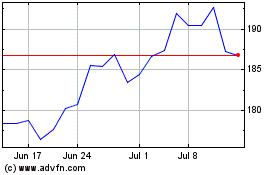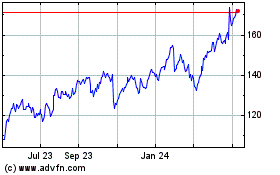IBM, Gogo Team Up For In-Flight Alerts -- WSJ
June 18 2016 - 3:03AM
Dow Jones News
By Rachael King
International Business Machines Inc. Thursday said it had struck
a deal with in-flight wireless provider Gogo Inc. to alert airline
pilots on the job to turbulence before they experience rough
skies.
The service is one of Big Blue's first moves to capitalize on
its $2 billion acquisition of The Weather Company. IBM will
automatically receive reports of turbulence from planes in flight,
compare them with meteorological data to assess the severity of the
threat, and send alerts to other planes in the area.
The Armonk, N.Y., technology giant likened the system's
operation to the way drivers use a popular navigation app owned by
Alphabet Inc. to detect traffic jams and route around them.
"What Waze does for cars, we do for airlines," said Cameron
Clayton, CEO and general manager of The Weather Company, which
became a division of IBM last October.
IBM said that each year, turbulence costs airlines approximately
$100 million due to crew and passenger injuries, unscheduled
maintenance, and revenue lost while planes are out of service. The
new service could save some of that money by alerting pilots to
turbulence ahead so they can avoid it.
IBM plans to launch the service in late summer. The terms of the
deal weren't disclosed.
"When IBM acquired The Weather Company, we fully anticipated
this deal was more about the data than about getting their hands on
The Weather Company's technology," said Douglas Laney, an analyst
with research firm Gartner Inc. "IBM has been plotting how to
deploy or monetize that data in a variety of ways to help justify
the investment," he added.
But The Weather Company's technology was also a factor in the
acquisition, according to a person familiar with the matter. The
company had built a platform that processes billions of data points
daily to produce actionable information, Mr. Clayton said.
While the platform has been used mostly for weather data, it
processes other kinds of data as well. It became a cornerstone of
IBM's Watson Internet of Things division, and it will manage the
turbulence alerts on the ground.
Usually, pilots who experience turbulence report the incident to
dispatchers on the ground, who evaluate the threat and set about
alerting other pilots who might be affected. IBM and Gogo intend to
automate the process.
Gogo, based in Chicago, Ill., will offer to outfit planes with a
dedicated Internet connection that connect to servers on the
ground. The system will pick up evidence of turbulence from sensors
already on a plane and relay it to Watson Internet of Things
computers, along with the plane's location. The IBM system will
combine the in-flight alerts with weather data such as wind speeds
to evaluate the severity of potential turbulence.
If the risk is minor, it will pass the information along to
planes in the area. If it senses a dangerous situation, it will
send an alert to reroute around the hazardous conditions.
IBM is also trying to wring revenue from The Weather Company's
websites and mobile app. On June 2, it announced Watson Ads, which
appear on The Weather Company properties. The ads let audience
members ask questions about products through voice or text, and use
the Watson artificial intelligence engine to answer them.
In February, Gogo signed a contract with global satellite
operator SES SA. The in-flight internet provider had struggled to
provide service on jetliners, and the contract provided a boost for
the company's in-flight internet service over the U.S., Latin
America and the North Atlantic.
Write to Rachael King at rachael.king@wsj.com
(END) Dow Jones Newswires
June 18, 2016 02:48 ET (06:48 GMT)
Copyright (c) 2016 Dow Jones & Company, Inc.
Alphabet (NASDAQ:GOOG)
Historical Stock Chart
From Mar 2024 to Apr 2024

Alphabet (NASDAQ:GOOG)
Historical Stock Chart
From Apr 2023 to Apr 2024
